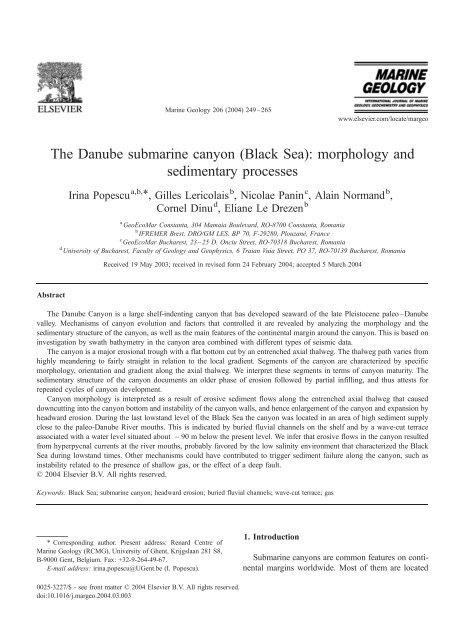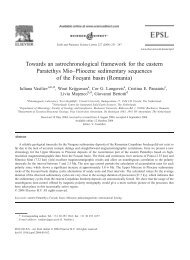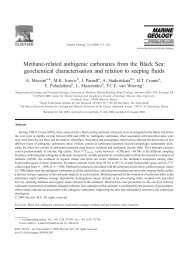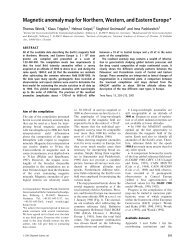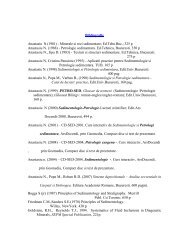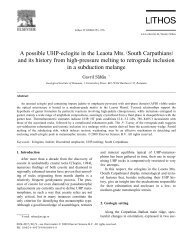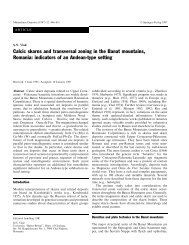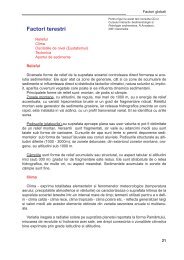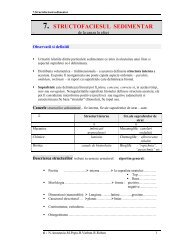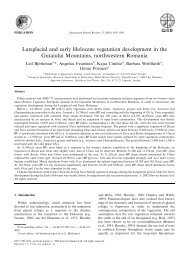The Danube submarine canyon (Black Sea ... - geo.edu.ro
The Danube submarine canyon (Black Sea ... - geo.edu.ro
The Danube submarine canyon (Black Sea ... - geo.edu.ro
Create successful ePaper yourself
Turn your PDF publications into a flip-book with our unique Google optimized e-Paper software.
Marine Geology 206 (2004) 249–265<br />
www.elsevier.com/locate/mar<st<strong>ro</strong>ng>geo</st<strong>ro</strong>ng><br />
<st<strong>ro</strong>ng>The</st<strong>ro</strong>ng> <st<strong>ro</strong>ng>Danube</st<strong>ro</strong>ng> <st<strong>ro</strong>ng>submarine</st<strong>ro</strong>ng> <st<strong>ro</strong>ng>canyon</st<strong>ro</strong>ng> (<st<strong>ro</strong>ng>Black</st<strong>ro</strong>ng> <st<strong>ro</strong>ng>Sea</st<strong>ro</strong>ng>): morphology and<br />
sedimentary p<strong>ro</strong>cesses<br />
Irina Popescu a,b, *, Gilles Lericolais b , Nicolae Panin c , Alain Normand b ,<br />
Cornel Dinu d , Eliane Le Drezen b<br />
a GeoEcoMar Constanta, 304 Mamaia Boulevard, RO-8700 Constanta, Romania<br />
b IFREMER Brest, DRO/GM LES, BP 70, F-29280, Plouzané, France<br />
c GeoEcoMar Bucharest, 23–25 D. Onciu Street, RO-70318 Bucharest, Romania<br />
d University of Bucharest, Faculty of Geology and Geophysics, 6 Traian Vuia Street, PO 37, RO-70139 Bucharest, Romania<br />
Received 19 May 2003; received in revised form 24 February 2004; accepted 5 March 2004<br />
Abstract<br />
<st<strong>ro</strong>ng>The</st<strong>ro</strong>ng> <st<strong>ro</strong>ng>Danube</st<strong>ro</strong>ng> Canyon is a large shelf-indenting <st<strong>ro</strong>ng>canyon</st<strong>ro</strong>ng> that has developed seaward of the late Pleistocene paleo–<st<strong>ro</strong>ng>Danube</st<strong>ro</strong>ng><br />
valley. Mechanisms of <st<strong>ro</strong>ng>canyon</st<strong>ro</strong>ng> evolution and factors that cont<strong>ro</strong>lled it are revealed by analyzing the morphology and the<br />
sedimentary structure of the <st<strong>ro</strong>ng>canyon</st<strong>ro</strong>ng>, as well as the main features of the continental margin a<strong>ro</strong>und the <st<strong>ro</strong>ng>canyon</st<strong>ro</strong>ng>. This is based on<br />
investigation by swath bathymetry in the <st<strong>ro</strong>ng>canyon</st<strong>ro</strong>ng> area combined with different types of seismic data.<br />
<st<strong>ro</strong>ng>The</st<strong>ro</strong>ng> <st<strong>ro</strong>ng>canyon</st<strong>ro</strong>ng> is a major e<strong>ro</strong>sional t<strong>ro</strong>ugh with a flat bottom cut by an entrenched axial thalweg. <st<strong>ro</strong>ng>The</st<strong>ro</strong>ng> thalweg path varies f<strong>ro</strong>m<br />
highly meandering to fairly straight in relation to the local gradient. Segments of the <st<strong>ro</strong>ng>canyon</st<strong>ro</strong>ng> are characterized by specific<br />
morphology, orientation and gradient along the axial thalweg. We interpret these segments in terms of <st<strong>ro</strong>ng>canyon</st<strong>ro</strong>ng> maturity. <st<strong>ro</strong>ng>The</st<strong>ro</strong>ng><br />
sedimentary structure of the <st<strong>ro</strong>ng>canyon</st<strong>ro</strong>ng> documents an older phase of e<strong>ro</strong>sion followed by partial infilling, and thus attests for<br />
repeated cycles of <st<strong>ro</strong>ng>canyon</st<strong>ro</strong>ng> development.<br />
Canyon morphology is interpreted as a result of e<strong>ro</strong>sive sediment flows along the entrenched axial thalweg that caused<br />
downcutting into the <st<strong>ro</strong>ng>canyon</st<strong>ro</strong>ng> bottom and instability of the <st<strong>ro</strong>ng>canyon</st<strong>ro</strong>ng> walls, and hence enlargement of the <st<strong>ro</strong>ng>canyon</st<strong>ro</strong>ng> and expansion by<br />
headward e<strong>ro</strong>sion. During the last lowstand level of the <st<strong>ro</strong>ng>Black</st<strong>ro</strong>ng> <st<strong>ro</strong>ng>Sea</st<strong>ro</strong>ng> the <st<strong>ro</strong>ng>canyon</st<strong>ro</strong>ng> was located in an area of high sediment supply<br />
close to the paleo-<st<strong>ro</strong>ng>Danube</st<strong>ro</strong>ng> River mouths. This is indicated by buried fluvial channels on the shelf and by a wave-cut terrace<br />
associated with a water level situated about 90 m below the present level. We infer that e<strong>ro</strong>sive flows in the <st<strong>ro</strong>ng>canyon</st<strong>ro</strong>ng> resulted<br />
f<strong>ro</strong>m hyperpycnal currents at the river mouths, p<strong>ro</strong>bably favored by the low salinity envi<strong>ro</strong>nment that characterized the <st<strong>ro</strong>ng>Black</st<strong>ro</strong>ng><br />
<st<strong>ro</strong>ng>Sea</st<strong>ro</strong>ng> during lowstand times. Other mechanisms could have contributed to trigger sediment failure along the <st<strong>ro</strong>ng>canyon</st<strong>ro</strong>ng>, such as<br />
instability related to the presence of shallow gas, or the effect of a deep fault.<br />
D 2004 Elsevier B.V. All rights reserved.<br />
Keywords: <st<strong>ro</strong>ng>Black</st<strong>ro</strong>ng> <st<strong>ro</strong>ng>Sea</st<strong>ro</strong>ng>; <st<strong>ro</strong>ng>submarine</st<strong>ro</strong>ng> <st<strong>ro</strong>ng>canyon</st<strong>ro</strong>ng>; headward e<strong>ro</strong>sion; buried fluvial channels; wave-cut terrace; gas<br />
* Corresponding author. Present address: Renard Centre of<br />
Marine Geology (RCMG), University of Ghent, Krijgslaan 281 S8,<br />
B-9000 Gent, Belgium. Fax: +32-9-264-49-67.<br />
E-mail address: irina.popescu@UGent.be (I. Popescu).<br />
1. Int<strong>ro</strong>duction<br />
Submarine <st<strong>ro</strong>ng>canyon</st<strong>ro</strong>ng>s are common features on continental<br />
margins worldwide. Most of them are located<br />
0025-3227/$ - see f<strong>ro</strong>nt matter D 2004 Elsevier B.V. All rights reserved.<br />
doi:10.1016/j.mar<st<strong>ro</strong>ng>geo</st<strong>ro</strong>ng>.2004.03.003
250<br />
I. Popescu et al. / Marine Geology 206 (2004) 249–265<br />
entirely on the upper slope, but there are also a<br />
relatively few large <st<strong>ro</strong>ng>canyon</st<strong>ro</strong>ng>s with heads that deeply<br />
indent the shelfbreak. It was suggested that slopeconfined<br />
and shelf-indenting <st<strong>ro</strong>ng>canyon</st<strong>ro</strong>ng>s represent different<br />
stages of <st<strong>ro</strong>ng>canyon</st<strong>ro</strong>ng> evolution, and that shelf-indenting<br />
<st<strong>ro</strong>ng>canyon</st<strong>ro</strong>ng>s evolved f<strong>ro</strong>m slope-confined <st<strong>ro</strong>ng>canyon</st<strong>ro</strong>ng>s<br />
(Twichell and Roberts, 1982), so that breaching the<br />
shelfbreak would correspond to the passage f<strong>ro</strong>m a<br />
youthful to a mature phase in <st<strong>ro</strong>ng>canyon</st<strong>ro</strong>ng> evolution (Farre<br />
et al., 1983). <st<strong>ro</strong>ng>The</st<strong>ro</strong>ng> most active <st<strong>ro</strong>ng>canyon</st<strong>ro</strong>ng> development<br />
seems to occur in the vicinity of the depocenter areas<br />
(Pratson et al., 1994) while shelf-indented <st<strong>ro</strong>ng>canyon</st<strong>ro</strong>ng>s<br />
commonly connected with the path of a river during<br />
lowstand times. This type of connection was extensively<br />
documented on various continental margins<br />
(Twichell et al., 1977; Kolla and Perlmutter, 1993;<br />
Fulthorpe et al., 1999). In some cases, <st<strong>ro</strong>ng>canyon</st<strong>ro</strong>ng>s cut<br />
into the shelf deposits as far as the modern coastline<br />
and reach the river mouths, as Zaire Canyon<br />
(Babonneau et al., 2002) or Canyon of Capbreton<br />
(Cirac et al., 2001).<br />
A number of these shelf-indenting <st<strong>ro</strong>ng>canyon</st<strong>ro</strong>ng>s are<br />
associated with large mud-rich deep-sea fan systems<br />
(as the Amazon Fan, the Mississippi Fan, the Indus<br />
Fan or the Bengal Fan). <st<strong>ro</strong>ng>The</st<strong>ro</strong>ng>re is general agreement<br />
that <st<strong>ro</strong>ng>canyon</st<strong>ro</strong>ng>s acted as the main conduits for transferring<br />
river-borne sediments towards the deep sea and<br />
fed the fan system (Kolla and Coumes, 1987; Kolla<br />
and Perlmutter, 1993; Flood et al., 1997; Kottke et al.,<br />
2003). Still, <st<strong>ro</strong>ng>canyon</st<strong>ro</strong>ng> genesis and evolution are far to be<br />
understood even though the corresponding deep-sea<br />
fans have been tho<strong>ro</strong>ughly studied.<br />
<st<strong>ro</strong>ng>The</st<strong>ro</strong>ng> <st<strong>ro</strong>ng>Danube</st<strong>ro</strong>ng> Canyon (also known as Viteaz Canyon)<br />
is a large shelf-indenting <st<strong>ro</strong>ng>canyon</st<strong>ro</strong>ng> located in the<br />
north-western <st<strong>ro</strong>ng>Black</st<strong>ro</strong>ng> <st<strong>ro</strong>ng>Sea</st<strong>ro</strong>ng> and connected to the youngest<br />
channel-levee system of the <st<strong>ro</strong>ng>Danube</st<strong>ro</strong>ng> Fan (Fig. 1).<br />
Here we discuss the detailed morphology and structure<br />
of the <st<strong>ro</strong>ng>Danube</st<strong>ro</strong>ng> Canyon and attempt to define<br />
sedimentary p<strong>ro</strong>cesses that marked its evolution. <st<strong>ro</strong>ng>The</st<strong>ro</strong>ng><br />
purpose of this paper is to evaluate the development<br />
of a large shelf-indenting <st<strong>ro</strong>ng>canyon</st<strong>ro</strong>ng> and to identify the<br />
main <st<strong>ro</strong>ng>canyon</st<strong>ro</strong>ng>-forming forces. Our results are based on<br />
data collected during the BlaSON French–Romanian<br />
survey in 1998 on the R/V Le Su<strong>ro</strong>ît, by IFREMER<br />
and GeoEcoMar (Fig. 1). <st<strong>ro</strong>ng>The</st<strong>ro</strong>ng> SIMRAD EM1000<br />
multibeam echosounder p<strong>ro</strong>vided the bathymetry<br />
and acoustic imagery data that were p<strong>ro</strong>cessed at<br />
IFREMER with the CARAIBES software. High-resolution<br />
seismic p<strong>ro</strong>filing was carried out along the<br />
<st<strong>ro</strong>ng>Danube</st<strong>ro</strong>ng> <st<strong>ro</strong>ng>canyon</st<strong>ro</strong>ng> using a mini-GI air-gun seismic<br />
source (frequency range 150 Hz) and a 24-channel<br />
streamer. Chirp-sonar data were acquired in parallel in<br />
order to investigate the surficial sediments. We also<br />
used 50 sub-bottom p<strong>ro</strong>files (3.5 kHz) acquired by<br />
GeoEcoMar in 1979–1983 on the Romanian shelf,<br />
and 10 industrial seismic lines p<strong>ro</strong>vided by the<br />
Romanian company Pet<strong>ro</strong>m (Fig. 1).<br />
2. Backg<strong>ro</strong>und<br />
2.1. General setting<br />
<st<strong>ro</strong>ng>The</st<strong>ro</strong>ng> north-western part of the <st<strong>ro</strong>ng>Black</st<strong>ro</strong>ng> <st<strong>ro</strong>ng>Sea</st<strong>ro</strong>ng> is the main<br />
depocentre for sediment supply f<strong>ro</strong>m Central Eu<strong>ro</strong>pe<br />
via the <st<strong>ro</strong>ng>Danube</st<strong>ro</strong>ng> River, but also f<strong>ro</strong>m Eastern Eu<strong>ro</strong>pe<br />
th<strong>ro</strong>ugh the Ukrainian rivers Dniepr, Dniestr and<br />
Southern Bug (Fig. 1). <st<strong>ro</strong>ng>The</st<strong>ro</strong>ng> shelf is particularly wide<br />
in this part of the basin (about 140 km with a maximum<br />
of 170 km off the mouth of the Dniepr River) and<br />
nar<strong>ro</strong>ws to both the east and west (Fig. 1). <st<strong>ro</strong>ng>The</st<strong>ro</strong>ng> shelfbreak<br />
is located at water depths of 120–140 m<br />
southward of the <st<strong>ro</strong>ng>Danube</st<strong>ro</strong>ng> Canyon, and up to 170<br />
m northward of the <st<strong>ro</strong>ng>canyon</st<strong>ro</strong>ng> possibly due to recent<br />
faulting which is very common in this area.<br />
<st<strong>ro</strong>ng>The</st<strong>ro</strong>ng> continental slope is dissected by nume<strong>ro</strong>us<br />
<st<strong>ro</strong>ng>canyon</st<strong>ro</strong>ng>s, each of which is fed by several tributaries<br />
(Fig. 2). <st<strong>ro</strong>ng>The</st<strong>ro</strong>ng>se <st<strong>ro</strong>ng>canyon</st<strong>ro</strong>ng>s commonly stop at the shelfbreak<br />
or slightly upward f<strong>ro</strong>m it. <st<strong>ro</strong>ng>The</st<strong>ro</strong>ng> unique and<br />
notable exception is the <st<strong>ro</strong>ng>Danube</st<strong>ro</strong>ng> Canyon, a feature<br />
that is deeply incised into the shelf for 26 km<br />
landward of the shelfbreak, up to 110 m water<br />
depth (Fig. 2). <st<strong>ro</strong>ng>The</st<strong>ro</strong>ng> <st<strong>ro</strong>ng>Danube</st<strong>ro</strong>ng> Canyon is the most recent<br />
major shelf-indenting <st<strong>ro</strong>ng>canyon</st<strong>ro</strong>ng> in this part of the<br />
margin and its relief is still preserved in the sea floor<br />
morphology, unlike other completely filled <st<strong>ro</strong>ng>canyon</st<strong>ro</strong>ng>s<br />
identified in the Plio-Quaternary shelf deposits (Lericolais<br />
et al., 1998). <st<strong>ro</strong>ng>The</st<strong>ro</strong>ng> <st<strong>ro</strong>ng>Danube</st<strong>ro</strong>ng> Canyon is located on<br />
the outer shelf and does not p<strong>ro</strong>long on the upper<br />
slope as an e<strong>ro</strong>sive t<strong>ro</strong>ugh like most of the <st<strong>ro</strong>ng>canyon</st<strong>ro</strong>ng>s<br />
worldwide. Instead, after capturing several tributaries<br />
near the shelfbreak, the system continues basinward as<br />
a channel with well-developed levees. This represents<br />
the <st<strong>ro</strong>ng>Danube</st<strong>ro</strong>ng> Channel, the youngest channel-levee<br />
system in the <st<strong>ro</strong>ng>Danube</st<strong>ro</strong>ng> fan (Popescu et al., 2001;<br />
Popescu, 2002).
I. Popescu et al. / Marine Geology 206 (2004) 249–265 251<br />
Study<br />
area<br />
<st<strong>ro</strong>ng>Danube</st<strong>ro</strong>ng> Canyon<br />
<st<strong>ro</strong>ng>Danube</st<strong>ro</strong>ng> Channel<br />
Fig. 1. General map of the <st<strong>ro</strong>ng>Black</st<strong>ro</strong>ng> <st<strong>ro</strong>ng>Sea</st<strong>ro</strong>ng> showing the study area, and the location of the <st<strong>ro</strong>ng>Danube</st<strong>ro</strong>ng> Canyon. <st<strong>ro</strong>ng>The</st<strong>ro</strong>ng> <st<strong>ro</strong>ng>canyon</st<strong>ro</strong>ng> is connected to the <st<strong>ro</strong>ng>Danube</st<strong>ro</strong>ng><br />
Channel, the youngest channel-levee system of the <st<strong>ro</strong>ng>Danube</st<strong>ro</strong>ng> Fan. Data sets used for this study are also figured.
252<br />
I. Popescu et al. / Marine Geology 206 (2004) 249–265<br />
<st<strong>ro</strong>ng>The</st<strong>ro</strong>ng> <st<strong>ro</strong>ng>Danube</st<strong>ro</strong>ng> Canyon has an e<strong>ro</strong>sive axial thalweg<br />
that continues beyond the shelfbreak as an<br />
entrenched thalweg in the <st<strong>ro</strong>ng>Danube</st<strong>ro</strong>ng> Channel (Fig. 2).<br />
Definitely, there is continuity between the mostly<br />
e<strong>ro</strong>sive <st<strong>ro</strong>ng>Danube</st<strong>ro</strong>ng> Canyon developing on the outer<br />
shelf, and the mostly depositional <st<strong>ro</strong>ng>Danube</st<strong>ro</strong>ng> Channel,<br />
located on the slope and in the deep basin. <st<strong>ro</strong>ng>The</st<strong>ro</strong>ng><br />
<st<strong>ro</strong>ng>Danube</st<strong>ro</strong>ng> Canyon thus represents the p<strong>ro</strong>ximal end of<br />
this system, and acted as its gateway for the sediment<br />
transfer towards the deep sea.<br />
2.2. Water-level changes<br />
During highstands the head of the <st<strong>ro</strong>ng>Danube</st<strong>ro</strong>ng> <st<strong>ro</strong>ng>canyon</st<strong>ro</strong>ng><br />
was separated f<strong>ro</strong>m the coastline by a wide shelf, so<br />
the <st<strong>ro</strong>ng>canyon</st<strong>ro</strong>ng>/channel-levee system was p<strong>ro</strong>bably inactive.<br />
As falling water level partially exposed the<br />
shelf, river sediment discharge moved towards the<br />
shelfedge, so that lowstand periods were considered<br />
as times of <st<strong>ro</strong>ng>canyon</st<strong>ro</strong>ng> and fan activity (Wong et al.,<br />
1994).<br />
However, it has to be noted that the <st<strong>ro</strong>ng>Black</st<strong>ro</strong>ng> <st<strong>ro</strong>ng>Sea</st<strong>ro</strong>ng> is a<br />
marginal basin, connected with the Mediterranean <st<strong>ro</strong>ng>Sea</st<strong>ro</strong>ng><br />
only by the shallow Strait of Bosphorus (currently 32<br />
m deep). For any water level below the depth of the<br />
strait, the <st<strong>ro</strong>ng>Black</st<strong>ro</strong>ng> <st<strong>ro</strong>ng>Sea</st<strong>ro</strong>ng> was an isolated basin, and its<br />
level oscillated independently f<strong>ro</strong>m the global eustasy.<br />
Consequently, lowstand periods in the <st<strong>ro</strong>ng>Black</st<strong>ro</strong>ng> <st<strong>ro</strong>ng>Sea</st<strong>ro</strong>ng> do<br />
not necessarily correspond to lowstands in the world<br />
ocean, but are related to regional wet–dry cycles<br />
(Chepalyga, 1985; Major, 2002).<br />
Another particular feature of the <st<strong>ro</strong>ng>Black</st<strong>ro</strong>ng> <st<strong>ro</strong>ng>Sea</st<strong>ro</strong>ng> basin<br />
is that times of isolation were characterized by a<br />
low salinity envi<strong>ro</strong>nment due to the absence of<br />
marine water influx, as indicated by the associations<br />
of fauna in the <st<strong>ro</strong>ng>Black</st<strong>ro</strong>ng> <st<strong>ro</strong>ng>Sea</st<strong>ro</strong>ng> sediments (Chepalyga,<br />
1985; Jones and Simmons, 1997). Hence, periods of<br />
<st<strong>ro</strong>ng>canyon</st<strong>ro</strong>ng> and fan activity were systematically associated<br />
with the fresh water phases of the basin,<br />
whereas their activity was interrupted during semimarine<br />
to marine highstand phases. This specificity<br />
is important for understanding potential mechanisms<br />
of <st<strong>ro</strong>ng>canyon</st<strong>ro</strong>ng> evolution, since lacustrine conditions are<br />
particularly favorable to the generation of quasisteady<br />
hyperpycnal turbidity flows at the river<br />
mouths, unlike the marine settings where they occur<br />
Fig. 2. Morphologic map of the north-western <st<strong>ro</strong>ng>Black</st<strong>ro</strong>ng> <st<strong>ro</strong>ng>Sea</st<strong>ro</strong>ng> margin in the <st<strong>ro</strong>ng>Danube</st<strong>ro</strong>ng> Canyon area. <st<strong>ro</strong>ng>The</st<strong>ro</strong>ng> <st<strong>ro</strong>ng>Danube</st<strong>ro</strong>ng> <st<strong>ro</strong>ng>canyon</st<strong>ro</strong>ng> is deeply incised into the<br />
shelf, whereas the other <st<strong>ro</strong>ng>canyon</st<strong>ro</strong>ng>s terminate at the shelfbreak. <st<strong>ro</strong>ng>The</st<strong>ro</strong>ng> <st<strong>ro</strong>ng>Danube</st<strong>ro</strong>ng> Canyon continues on the slope as a major channel-levee system: the<br />
<st<strong>ro</strong>ng>Danube</st<strong>ro</strong>ng> channel. On the shelf margin northward of the <st<strong>ro</strong>ng>Danube</st<strong>ro</strong>ng> Canyon, the seafloor is affected by recent faults, up to 15 m th<strong>ro</strong>w.
I. Popescu et al. / Marine Geology 206 (2004) 249–265 253<br />
only occasionally (Normark and Piper, 1991;<br />
Mulder and Alexander, 2001).<br />
3. General morphology and structure of the<br />
<st<strong>ro</strong>ng>Danube</st<strong>ro</strong>ng> Canyon<br />
3.1. Morphology<br />
<st<strong>ro</strong>ng>The</st<strong>ro</strong>ng> <st<strong>ro</strong>ng>Danube</st<strong>ro</strong>ng> Canyon indents the shelf for 26 km<br />
landward of the shelfbreak and follows a slightly<br />
sinuous path, with a general NW–SE orientation<br />
(Fig. 3). <st<strong>ro</strong>ng>The</st<strong>ro</strong>ng> <st<strong>ro</strong>ng>canyon</st<strong>ro</strong>ng> consists of an e<strong>ro</strong>sional major<br />
t<strong>ro</strong>ugh with steep flanks (up to 30j). <st<strong>ro</strong>ng>The</st<strong>ro</strong>ng> crest of the<br />
<st<strong>ro</strong>ng>canyon</st<strong>ro</strong>ng> walls is affected all over by crescent-shaped<br />
scars concave towards the thalweg. This t<strong>ro</strong>ugh is<br />
about 6 km wide near the shelfbreak and nar<strong>ro</strong>ws<br />
landward to 2 km. <st<strong>ro</strong>ng>The</st<strong>ro</strong>ng> flat bottom of this main valley<br />
is incised by a V-shaped axial thalweg, 400–600 m<br />
wide and up to 400 m deep, that continues beyond the<br />
shelfbreak as an entrenched thalweg in the <st<strong>ro</strong>ng>Danube</st<strong>ro</strong>ng><br />
Channel. <st<strong>ro</strong>ng>The</st<strong>ro</strong>ng> morphological features and the orientation<br />
vary significantly along the <st<strong>ro</strong>ng>canyon</st<strong>ro</strong>ng> (Fig. 3), as<br />
well as the gradient of the channel floor along the<br />
axial thalweg (Fig. 4). According to these variations,<br />
we separated five segments A to E. <st<strong>ro</strong>ng>The</st<strong>ro</strong>ng>ir characteristics<br />
are summarized in Table 1.<br />
Beyond the shelfbreak the system continues as a<br />
channel with well-developed lateral levees. <st<strong>ro</strong>ng>The</st<strong>ro</strong>ng> passage<br />
between the <st<strong>ro</strong>ng>canyon</st<strong>ro</strong>ng> and the channel along the<br />
thalweg p<strong>ro</strong>file is marked by a knickpoint (f<strong>ro</strong>m 0.34j<br />
to 0.71j). Downward of this knickpoint the p<strong>ro</strong>file<br />
becomes concave-up and relatively smooth, as usual<br />
in a channel–levee system in equilibrium (Pirmez and<br />
Flood, 1995; Babonneau et al., 2002).<br />
A secondary <st<strong>ro</strong>ng>canyon</st<strong>ro</strong>ng> head can be identified on the<br />
upper slope northward of the main <st<strong>ro</strong>ng>canyon</st<strong>ro</strong>ng> (Fig. 3). It<br />
is 7.7 km long, 1.2–2.4 km wide and follows a N–S<br />
direction up to the 140 m isobath. <st<strong>ro</strong>ng>The</st<strong>ro</strong>ng> axial<br />
thalweg is 300 m wide, slightly sinuous in the upper<br />
part and rather straight downward. Two other <st<strong>ro</strong>ng>canyon</st<strong>ro</strong>ng><br />
heads of the same type cut into the slope and converge<br />
with the main <st<strong>ro</strong>ng>canyon</st<strong>ro</strong>ng> northward of the zone covered<br />
by our swath bathymetry, as indicated by shallow<br />
seismics and classic bathymetry (Fig. 2). <st<strong>ro</strong>ng>The</st<strong>ro</strong>ng> only<br />
tributary situated on the southern side of the <st<strong>ro</strong>ng>canyon</st<strong>ro</strong>ng> is<br />
partially filled up and has no axial thalweg either on<br />
its surface or in its deep structure.<br />
3.2. Sedimentary structure<br />
<st<strong>ro</strong>ng>The</st<strong>ro</strong>ng> internal structure of the <st<strong>ro</strong>ng>canyon</st<strong>ro</strong>ng> as indicated<br />
by seismic reflection p<strong>ro</strong>files ac<strong>ro</strong>ss the <st<strong>ro</strong>ng>canyon</st<strong>ro</strong>ng><br />
shows a major e<strong>ro</strong>sional surface at about 240 m<br />
below the bottom of the modern axial thalweg<br />
(Figs. 5 and 6). <st<strong>ro</strong>ng>The</st<strong>ro</strong>ng> abrupt walls of the major<br />
valley are clearly situated in p<strong>ro</strong>longation of this<br />
surface in segment C, but also on the south-western<br />
flank in the segment D. This indicates a previous<br />
phase of e<strong>ro</strong>sion that initiated the formation of the<br />
<st<strong>ro</strong>ng>canyon</st<strong>ro</strong>ng> walls currently recognizable in the morphology.<br />
Partial infilling of the <st<strong>ro</strong>ng>canyon</st<strong>ro</strong>ng> followed this<br />
initial e<strong>ro</strong>sional phase. <st<strong>ro</strong>ng>The</st<strong>ro</strong>ng> <st<strong>ro</strong>ng>canyon</st<strong>ro</strong>ng> fill consists of a<br />
chaotic and relatively transparent facies overlain by<br />
a high amplitude bedded facies (Fig. 5). Temporal<br />
relations between the <st<strong>ro</strong>ng>canyon</st<strong>ro</strong>ng> fill and the current<br />
thalweg are hard to define without any g<strong>ro</strong>undtruthing<br />
information.<br />
<st<strong>ro</strong>ng>The</st<strong>ro</strong>ng> polyphased evolution of the <st<strong>ro</strong>ng>Danube</st<strong>ro</strong>ng> Canyon is<br />
not a unique case, as many <st<strong>ro</strong>ng>submarine</st<strong>ro</strong>ng> <st<strong>ro</strong>ng>canyon</st<strong>ro</strong>ng>s<br />
evolved over long time periods f<strong>ro</strong>m repeated e<strong>ro</strong>sional<br />
events of varying magnitude (Shepard, 1981).<br />
<st<strong>ro</strong>ng>The</st<strong>ro</strong>ng> Mississippi Canyon for instance shows evidence<br />
of at least two episodes of deposition and subsequent<br />
e<strong>ro</strong>sion in the <st<strong>ro</strong>ng>canyon</st<strong>ro</strong>ng> fill sediments (Goodwin and<br />
Prior, 1989), whereas the latest Indus Canyon underwent<br />
several episodes of cutting and filling as well<br />
(Kolla and Coumes, 1987).<br />
3.3. Interpretation of the morphologic and structural<br />
features<br />
Several segments were distinguished along the<br />
<st<strong>ro</strong>ng>Danube</st<strong>ro</strong>ng> Canyon as a function of their specific features<br />
(Fig. 3). We consider that these segments document<br />
the landward expansion of the <st<strong>ro</strong>ng>canyon</st<strong>ro</strong>ng> by headward<br />
e<strong>ro</strong>sion, and we interpret them in terms of <st<strong>ro</strong>ng>canyon</st<strong>ro</strong>ng><br />
maturity, as follows:<br />
1. Segments C, D and E are all characterized by a welldefined<br />
major t<strong>ro</strong>ugh with high walls increasingly<br />
steeper towards the distal end. <st<strong>ro</strong>ng>The</st<strong>ro</strong>ng> flat <st<strong>ro</strong>ng>canyon</st<strong>ro</strong>ng><br />
bottom is entrenched by a single axial thalweg that is<br />
p<strong>ro</strong>gressively more stable, straight and deep f<strong>ro</strong>m C<br />
to E (Table 1; Fig. 3). Segments C to E reflect longterm<br />
<st<strong>ro</strong>ng>canyon</st<strong>ro</strong>ng> evolution, so that they may be<br />
interpreted as the mature zone of the <st<strong>ro</strong>ng>canyon</st<strong>ro</strong>ng>.
254<br />
I. Popescu et al. / Marine Geology 206 (2004) 249–265<br />
2. Segment B is incised by several convergent paths<br />
of the axial thalweg (1–4 in Fig. 3). Longitudinal<br />
p<strong>ro</strong>file along these paths becomes less steep<br />
(therefore more stable) f<strong>ro</strong>m 4 to 1. <st<strong>ro</strong>ng>The</st<strong>ro</strong>ng> <st<strong>ro</strong>ng>canyon</st<strong>ro</strong>ng><br />
wall nearby these incised channels is gentler and<br />
less affected by failure scars than the opposite<br />
flank. This segment would correspond to a headward<br />
e<strong>ro</strong>sion zone, where downcutting along the<br />
unstable channel thalweg results in sediment<br />
failure at the <st<strong>ro</strong>ng>canyon</st<strong>ro</strong>ng> head.<br />
3. Segment A has no entrenched thalweg and its<br />
gentle flanks are not affected by failure scars. It is<br />
situated in p<strong>ro</strong>longation of a ramification of the<br />
axial thalweg in the segment B that shows the most<br />
stable longitudinal p<strong>ro</strong>file (path 4 in Figs. 3 and 4).<br />
This could indicate that the evolution of the <st<strong>ro</strong>ng>canyon</st<strong>ro</strong>ng><br />
(hypothetic because interrupted) would have led to<br />
the initiation of an entrenched axial thalweg in the<br />
segment A. We argue that segment A reflects an<br />
incipient phase of <st<strong>ro</strong>ng>canyon</st<strong>ro</strong>ng> development.<br />
As indicated by the deep structure, the modern<br />
<st<strong>ro</strong>ng>canyon</st<strong>ro</strong>ng> developed in a morphological context<br />
inherited f<strong>ro</strong>m at least one previous phase, and thus<br />
the distal part of the <st<strong>ro</strong>ng>canyon</st<strong>ro</strong>ng> reached maturity th<strong>ro</strong>ugh<br />
successive e<strong>ro</strong>sional cycles. Nevertheless, the youngest<br />
phase did not limit to transferring sediment<br />
th<strong>ro</strong>ugh an axial thalweg confined in a relict relief,<br />
but generated the immature zones of the <st<strong>ro</strong>ng>canyon</st<strong>ro</strong>ng>. Also,<br />
e<strong>ro</strong>sion in the axial thalweg resulted in failures enlarging<br />
the major valley in the mature segments D and<br />
E, directly (on the northern flank) or th<strong>ro</strong>ugh a system<br />
of lateral gullies (on the southern flank). Segment C is<br />
a zone affected by e<strong>ro</strong>sion as well: perched terraces<br />
were created by failures inside the major valley, while<br />
abandoned meanders nearby the <st<strong>ro</strong>ng>canyon</st<strong>ro</strong>ng> walls determined<br />
instability and widening of the <st<strong>ro</strong>ng>canyon</st<strong>ro</strong>ng>.<br />
4. Cont<strong>ro</strong>ls on the development of the <st<strong>ro</strong>ng>Danube</st<strong>ro</strong>ng><br />
Canyon<br />
4.1. High sediment input<br />
It has long been observed that many <st<strong>ro</strong>ng>submarine</st<strong>ro</strong>ng><br />
<st<strong>ro</strong>ng>canyon</st<strong>ro</strong>ng>s were spatially connected to rivers on the<br />
continent (Twichell et al., 1977; Fulthorpe et al.,<br />
1999). Computer modelling indicated that <st<strong>ro</strong>ng>canyon</st<strong>ro</strong>ng>s<br />
need not necessarily be linked to specific fluvial<br />
sources, still <st<strong>ro</strong>ng>canyon</st<strong>ro</strong>ng> evolution should be most active<br />
when sediment influx to the slope is greatest (Pratson<br />
and Coakley, 1996). Hyperpycnal currents generated<br />
by the river input can also enhance sediment transport<br />
along the sea bottom (Normark and Piper, 1991;<br />
Mulder and Alexander, 2001).<br />
Taking into account the location of our study zone<br />
in f<strong>ro</strong>nt of one of the largest Eu<strong>ro</strong>pean rivers, the<br />
possible effect of the river sediment supply on the<br />
<st<strong>ro</strong>ng>canyon</st<strong>ro</strong>ng> development has to be considered. Today the<br />
<st<strong>ro</strong>ng>Danube</st<strong>ro</strong>ng> Canyon is situated more than 100 km f<strong>ro</strong>m<br />
the <st<strong>ro</strong>ng>Danube</st<strong>ro</strong>ng> mouths. River sediment is trapped by<br />
southward currents along the coast and on the inner<br />
shelf, so that the outer shelf is sediment-starved and<br />
the supply in the <st<strong>ro</strong>ng>canyon</st<strong>ro</strong>ng> is currently interrupted<br />
(Panin, 1996). This was not the case during times of<br />
lowstand when part of the shelf was exposed, allowing<br />
direct fluvial sediment delivery to the shelfedge<br />
and to the <st<strong>ro</strong>ng>Danube</st<strong>ro</strong>ng> Canyon (Panin, 1989).<br />
In order to clarify the spatial relationship between<br />
the river and the <st<strong>ro</strong>ng>canyon</st<strong>ro</strong>ng>, it is critical to recognize (1)<br />
the location of the paleo-<st<strong>ro</strong>ng>Danube</st<strong>ro</strong>ng> river and (2) the<br />
location of the paleo-shoreline during the last lowstand<br />
period in the <st<strong>ro</strong>ng>Black</st<strong>ro</strong>ng> <st<strong>ro</strong>ng>Sea</st<strong>ro</strong>ng>, which was implicitly<br />
the last active period of the <st<strong>ro</strong>ng>canyon</st<strong>ro</strong>ng>. We investigated<br />
seafloor morphology and shallow stratigraphy of the<br />
continental shelf in f<strong>ro</strong>nt of the <st<strong>ro</strong>ng>Danube</st<strong>ro</strong>ng> mouths with<br />
the purpose of tracking buried fluvial channels—as a<br />
diagnostic feature of ancient drainage systems, and<br />
wave-cut terraces—generally considered as indicating<br />
the p<strong>ro</strong>ximity of the coastline.<br />
4.1.1. Paleo-rivers<br />
We identified nume<strong>ro</strong>us channels on the continental<br />
shelf down to 90 m water depth (Fig. 7).<br />
<st<strong>ro</strong>ng>The</st<strong>ro</strong>ng>se channels are e<strong>ro</strong>sive structures that are completely<br />
filled, and hence no longer visible in the<br />
bathymetry. <st<strong>ro</strong>ng>The</st<strong>ro</strong>ng>y reach 400–1500 m in width and<br />
20–30 m in depth, and show asymmetry on c<strong>ro</strong>sssections<br />
with reflectors that dip f<strong>ro</strong>m the gently<br />
sloping bank to terminate against the steeper bank<br />
(Fig. 8). Channels are sealed only by a thin mud<br />
drape parallel to the sea bottom that generally<br />
corresponds to the last highstand deposits. <st<strong>ro</strong>ng>The</st<strong>ro</strong>ng>re is<br />
no independent indication of the age of these<br />
incisions. However, their stratigraphic position lying<br />
directly under the discontinuity at the base of the
Fig. 3. Bathymetric 3D map of the <st<strong>ro</strong>ng>Danube</st<strong>ro</strong>ng> Canyon, obtained f<strong>ro</strong>m EM1000 data. <st<strong>ro</strong>ng>The</st<strong>ro</strong>ng> inset box shows a schematic representation of the <st<strong>ro</strong>ng>canyon</st<strong>ro</strong>ng> morphology, and the segments A to E<br />
separated along the <st<strong>ro</strong>ng>canyon</st<strong>ro</strong>ng>. Distinct paths of the thalweg in segment B are numbered 1 to 4. Shaded areas mark the steep <st<strong>ro</strong>ng>canyon</st<strong>ro</strong>ng> flanks.<br />
I. Popescu et al. / Marine Geology 206 (2004) 249–265 255
256<br />
I. Popescu et al. / Marine Geology 206 (2004) 249–265<br />
Fig. 4. Longitudinal depth p<strong>ro</strong>file along the axial thalweg of the <st<strong>ro</strong>ng>Danube</st<strong>ro</strong>ng> Canyon/Channel obtained f<strong>ro</strong>m EM1000 data. Segments B to E show<br />
distinct thalweg gradients. Mean slope gradients are indicated for each segment. In segment B, 1 to 4 represent different paths of the thalweg.<br />
Meanders of the thalweg in segment C are associated with the lowest gradient zone, whereas part of the sediment is deposed inside the thalweg<br />
as transverse bars. Transition f<strong>ro</strong>m the <st<strong>ro</strong>ng>canyon</st<strong>ro</strong>ng> to the channel-levee system is marked by a knickpoint.<br />
Holocene st<strong>ro</strong>ngly suggests that they formed during<br />
the last lowstand. Several channels are c<strong>ro</strong>ssed by<br />
each seismic p<strong>ro</strong>file, which indicates an anastomosed<br />
fluvial system and/or a large number of<br />
tributaries.<br />
<st<strong>ro</strong>ng>The</st<strong>ro</strong>ng> distribution of the buried channels clusters<br />
a<strong>ro</strong>und two main directions that seem to correspond<br />
to two distinct drainage systems (Fig. 7).<br />
<st<strong>ro</strong>ng>The</st<strong>ro</strong>ng> southern system directs straight towards the<br />
<st<strong>ro</strong>ng>Danube</st<strong>ro</strong>ng> mouths and most p<strong>ro</strong>bably represents the<br />
paleo-<st<strong>ro</strong>ng>Danube</st<strong>ro</strong>ng> River. Before the construction of the<br />
Holocene deltaic edifice, the paleo-<st<strong>ro</strong>ng>Danube</st<strong>ro</strong>ng> p<strong>ro</strong>bably<br />
followed a path in p<strong>ro</strong>longation of the modern Sf.<br />
Gheorghe arm. Still, a direct connection cannot be<br />
established due to the acoustic masking of shallow gas<br />
in the <st<strong>ro</strong>ng>Danube</st<strong>ro</strong>ng> p<strong>ro</strong>delta. On the outer shelf the river<br />
apparently splits into several arms similar to a fluvial<br />
deltaic structure that is comparable in size to the<br />
modern <st<strong>ro</strong>ng>Danube</st<strong>ro</strong>ng> Delta and lies close to the <st<strong>ro</strong>ng>Danube</st<strong>ro</strong>ng><br />
Canyon.<br />
<st<strong>ro</strong>ng>The</st<strong>ro</strong>ng> origin of the northern system is uncertain<br />
because of the total lack of information concerning<br />
Table 1<br />
Characteristics of the segments A to E separated along the <st<strong>ro</strong>ng>Danube</st<strong>ro</strong>ng> Canyon (see also Figs. 3 and 4)<br />
Segment A B C D E<br />
Orientation NNW–SSE NW–SE WNW –ESE NNW–SSE NW–SE<br />
Width (km) 2 3.2–4.8 4.8–6 6 6<br />
Flank gradient (j) < 5 < 15 15–30 20–30 20–30<br />
Canyon depth a (m) < 40 < 230 < 400 600 600<br />
Thalweg features No thalweg Several distinct paths<br />
(1–4)<br />
Single, highly meandering,<br />
with transversal bars<br />
Single, slightly sinuous,<br />
stable<br />
Single, straight,<br />
stable<br />
Thalweg depth (m) – < 30 30–50 < 150 150<br />
Gradient along the<br />
axial thalweg (j)<br />
– – 0.31 0.47 0.34<br />
Other features – Youngest thalweg path<br />
has the most stable<br />
p<strong>ro</strong>file<br />
a Major valley and axial thalweg.<br />
Abandoned meanders on<br />
the flat bottom of the<br />
major valley<br />
Lateral gullies inside the<br />
major valley<br />
Flanks locally join<br />
the thalweg
I. Popescu et al. / Marine Geology 206 (2004) 249–265 257<br />
Fig. 5. Sedimentary structure of the <st<strong>ro</strong>ng>Danube</st<strong>ro</strong>ng> Canyon (part of seismic industrial p<strong>ro</strong>file P941S-44, location in Fig. 2). <st<strong>ro</strong>ng>The</st<strong>ro</strong>ng> line is situated ac<strong>ro</strong>ss<br />
segment D. Canyon steep flanks are in p<strong>ro</strong>longation of an ancient e<strong>ro</strong>sional surface (marked in dashed line), documenting a previous phase of<br />
<st<strong>ro</strong>ng>canyon</st<strong>ro</strong>ng> development. <st<strong>ro</strong>ng>The</st<strong>ro</strong>ng> infill consists of a chaotic seismic facies overlain by a high amplitude bedded facies, and is incised by the modern<br />
thalweg.<br />
its course on the inner Ukrainian shelf. Scherbakov et<br />
al. (1978) mapped a river system with more or less<br />
the same direction that originated in a small river<br />
situated between the <st<strong>ro</strong>ng>Danube</st<strong>ro</strong>ng> and the Dniestr currently<br />
flowing in a littoral lagoon, yet the question<br />
remains open.<br />
4.1.2. Paleo-coastline<br />
<st<strong>ro</strong>ng>The</st<strong>ro</strong>ng> absence of incised river channels below 90<br />
m water depth could not indicate unequivocally the<br />
paleo-coastline if not sustained by other arguments,<br />
since rivers do not always generate continuous c<strong>ro</strong>ssshelf<br />
incised valleys (Talling, 1998; Lericolais et al.,<br />
2001; Posamentier, 2001).<br />
Wave-cut terraces are e<strong>ro</strong>sional surfaces created by<br />
wave abrasion, and indicate the vicinity of the shoreline.<br />
We mapped a submerged wave-cut terrace on the<br />
outer shelf of the north-western <st<strong>ro</strong>ng>Black</st<strong>ro</strong>ng> <st<strong>ro</strong>ng>Sea</st<strong>ro</strong>ng> for about<br />
100 km (Figs. 7 and 9). <st<strong>ro</strong>ng>The</st<strong>ro</strong>ng> terrace wraps a<strong>ro</strong>und the<br />
head of the <st<strong>ro</strong>ng>canyon</st<strong>ro</strong>ng> and its features vary along its path.<br />
Southward of the <st<strong>ro</strong>ng>Danube</st<strong>ro</strong>ng> Canyon the wave-cut terrace<br />
developed between 98 and 112 m water<br />
depth and clearly truncates the low angle clinoforms<br />
of a p<strong>ro</strong>grading facies (Fig. 9). <st<strong>ro</strong>ng>The</st<strong>ro</strong>ng> depth of the<br />
terrace gradually decreases when app<strong>ro</strong>aching the<br />
<st<strong>ro</strong>ng>canyon</st<strong>ro</strong>ng> up to about 90 m. Behind the head of the<br />
<st<strong>ro</strong>ng>canyon</st<strong>ro</strong>ng> the terrace is even shallower and significantly<br />
less marked (only 5–6 m height), so that its path is<br />
uncertain. Northward of the <st<strong>ro</strong>ng>Danube</st<strong>ro</strong>ng> Canyon the<br />
terrace deepens again to 97 m while the height<br />
increases to 10–15 m, and splits into two distinct<br />
steps. <st<strong>ro</strong>ng>The</st<strong>ro</strong>ng> variable depth of the terrace seems to be<br />
related to the presence of the <st<strong>ro</strong>ng>canyon</st<strong>ro</strong>ng> since the terrace<br />
is obviously shallowest a<strong>ro</strong>und the <st<strong>ro</strong>ng>canyon</st<strong>ro</strong>ng> head.<br />
Moreover, a similar variation of the depth of the<br />
terraces was noticed in the northern part of the <st<strong>ro</strong>ng>Black</st<strong>ro</strong>ng><br />
<st<strong>ro</strong>ng>Sea</st<strong>ro</strong>ng> basin (Major, 2002). This could be the effect of<br />
the redistribution of wave energy when app<strong>ro</strong>aching<br />
the shoreline, as energy is focused on p<strong>ro</strong>montories<br />
and dispersed in gulfs.<br />
<st<strong>ro</strong>ng>The</st<strong>ro</strong>ng> last lowstand paleo-coastline should thus have<br />
been situated between this submerged terrace and the<br />
deepest buried fluvial channels (Fig. 7).<br />
<st<strong>ro</strong>ng>The</st<strong>ro</strong>ng> topic of the last lowstand level of the <st<strong>ro</strong>ng>Black</st<strong>ro</strong>ng><br />
<st<strong>ro</strong>ng>Sea</st<strong>ro</strong>ng> has been recently questioned, especially in the<br />
context of the highly debated topic of the catast<strong>ro</strong>phic<br />
flood that followed this lowstand, p<strong>ro</strong>posed by Ryan<br />
et al. (1997). <st<strong>ro</strong>ng>The</st<strong>ro</strong>ng> majority of Russian authors indicated<br />
a sea level lowstand at about 90 m depth,<br />
based on the location of the offshore sand ridges that<br />
formed at the shelf edge south of Crimea; overdeepening<br />
of river valleys could suggest a maximum
258<br />
I. Popescu et al. / Marine Geology 206 (2004) 249–265<br />
Fig. 6. Sedimentary structure of the <st<strong>ro</strong>ng>Danube</st<strong>ro</strong>ng> Canyon (part of 24-channel seismic reflection p<strong>ro</strong>file b053, location in Fig. 2). <st<strong>ro</strong>ng>The</st<strong>ro</strong>ng> p<strong>ro</strong>file is<br />
situated ac<strong>ro</strong>ss segment C. Dashed line marks an ancient e<strong>ro</strong>sional surface in p<strong>ro</strong>logation of the modern flanks. Canyon fill is partially masked<br />
by gas. <st<strong>ro</strong>ng>The</st<strong>ro</strong>ng> meandering axial entrenched thalweg is c<strong>ro</strong>ssed several times.<br />
lowstand level of about 110 m (Chepalyga, 1985<br />
and references therein). More recent studies p<strong>ro</strong>posed<br />
a depth of 105 m, according to a regional e<strong>ro</strong>sional<br />
truncation on the southern coast of the <st<strong>ro</strong>ng>Black</st<strong>ro</strong>ng> <st<strong>ro</strong>ng>Sea</st<strong>ro</strong>ng><br />
(Demirbağ et al., 1999; Görür et al., 2001) but also<br />
based on a terrace on the northern shelf edge (Major,<br />
2002). In contrast, some authors suggested that the<br />
lowstand level of the <st<strong>ro</strong>ng>Black</st<strong>ro</strong>ng> <st<strong>ro</strong>ng>Sea</st<strong>ro</strong>ng> reached 150 m<br />
depth, mainly founded on a regional discontinuity on<br />
the northern shelf which is interpreted as a sub-aerial<br />
e<strong>ro</strong>sion surface (Ryan et al., 1997), and on features<br />
described as shoreline deposits on the margin of<br />
Turkey (Ballard et al., 2000).<br />
Our data do not p<strong>ro</strong>vide any indication of shoreline<br />
at 150 m, either in the <st<strong>ro</strong>ng>Danube</st<strong>ro</strong>ng> Canyon or along the<br />
shelf edge. Instead, they show (1) a great number of<br />
buried fluvial channels on the shelf that suddenly<br />
disappear below 90 m depth, and (2) a unique<br />
wave-cut terrace on the outer shelf, with an upper<br />
surface varying between 90 and 98 m. This is<br />
consistent with a major lowstand level situated somewhere<br />
a<strong>ro</strong>und 90 m depth.<br />
Consequently, during the last water lowstand the<br />
<st<strong>ro</strong>ng>Danube</st<strong>ro</strong>ng> Canyon clearly evolved in a shallow envi<strong>ro</strong>nment<br />
affected by high sediment supply. <st<strong>ro</strong>ng>The</st<strong>ro</strong>ng> paleocoastline<br />
was forming a wide gulf in which two rivers<br />
were flowing. <st<strong>ro</strong>ng>The</st<strong>ro</strong>ng> <st<strong>ro</strong>ng>canyon</st<strong>ro</strong>ng> was entirely submerged<br />
and situated in the southern part of this gulf, in f<strong>ro</strong>nt<br />
of the paleo-<st<strong>ro</strong>ng>Danube</st<strong>ro</strong>ng> mouths and below the base of the<br />
wave-action zone, as attested by the position of the<br />
wave-cut terrace.<br />
Meanwhile, it should be noted that the <st<strong>ro</strong>ng>canyon</st<strong>ro</strong>ng><br />
developed under freshwater conditions. <st<strong>ro</strong>ng>The</st<strong>ro</strong>ng> short<br />
distance between the river mouths and the <st<strong>ro</strong>ng>canyon</st<strong>ro</strong>ng><br />
head, under envi<strong>ro</strong>nmental conditions that particularly<br />
favor the formation of hyperpycnal currents<br />
suggests that the high sedimentary influx via the<br />
paleo-<st<strong>ro</strong>ng>Danube</st<strong>ro</strong>ng> was a major cont<strong>ro</strong>l on the <st<strong>ro</strong>ng>canyon</st<strong>ro</strong>ng><br />
development.<br />
4.2. Structural cont<strong>ro</strong>l<br />
It is well established that <st<strong>ro</strong>ng>submarine</st<strong>ro</strong>ng> <st<strong>ro</strong>ng>canyon</st<strong>ro</strong>ng>s evolution<br />
may be governed by a predominant structural<br />
cont<strong>ro</strong>l, especially along active continental margins<br />
(Shepard, 1981). In this respect, the <st<strong>ro</strong>ng>geo</st<strong>ro</strong>ng>metry of the<br />
<st<strong>ro</strong>ng>canyon</st<strong>ro</strong>ng> of Capbreton on the eastern Atlantic margin<br />
consisting of a succession of sections with different<br />
orientations was associated with the structural backg<strong>ro</strong>und<br />
cont<strong>ro</strong>lled by a network of faults (Cirac et al.,<br />
2001). <st<strong>ro</strong>ng>The</st<strong>ro</strong>ng> <st<strong>ro</strong>ng>Danube</st<strong>ro</strong>ng> Canyon displays the same type of<br />
<st<strong>ro</strong>ng>geo</st<strong>ro</strong>ng>metry, but the possible relationship between the<br />
changing direction along the <st<strong>ro</strong>ng>canyon</st<strong>ro</strong>ng> and the local<br />
tectonics remains unclear.
I. Popescu et al. / Marine Geology 206 (2004) 249–265 259<br />
Fig. 7. Paleo<st<strong>ro</strong>ng>geo</st<strong>ro</strong>ng>graphic map of the north-western <st<strong>ro</strong>ng>Black</st<strong>ro</strong>ng> <st<strong>ro</strong>ng>Sea</st<strong>ro</strong>ng> margin during the last sea-level lowstand. Individual buried channels identified on<br />
shallow seismic p<strong>ro</strong>files are marked, as well as the location of the submerged wave-cut terrace (WT). Areas characterized by dense occurrence<br />
of buried channels cluster in two main paleo-drainage systems. <st<strong>ro</strong>ng>The</st<strong>ro</strong>ng> presumed position of the Peceneaga-Camena fault is drawn after Winguth et<br />
al. (2000) and Dinu et al. (2002). In the vicinity of the modern coastline the paleo-<st<strong>ro</strong>ng>Danube</st<strong>ro</strong>ng> buried system is masked by extensive shallow gas in<br />
the <st<strong>ro</strong>ng>Danube</st<strong>ro</strong>ng> p<strong>ro</strong>delta.
260<br />
I. Popescu et al. / Marine Geology 206 (2004) 249–265<br />
Fig. 8. Example of fluvial buried channels on the continental shelf (part of 3.5 kHz seismic reflection p<strong>ro</strong>file L/81, location in Fig. 2). <st<strong>ro</strong>ng>The</st<strong>ro</strong>ng><br />
asymmetrical pattern of the fill is most likely the result of lateral accretion and p<strong>ro</strong>gressive infilling of a meandering river.<br />
Nevertheless, as observed by Wong et al. (1994),<br />
the <st<strong>ro</strong>ng>Danube</st<strong>ro</strong>ng> Canyon is situated along the p<strong>ro</strong>longation<br />
of the Peceneaga-Camena fault that is a major crustal<br />
fault at the contact between the North Dob<strong>ro</strong>gea<br />
O<strong>ro</strong>gen and the Moesian Platform (Fig. 7). This fault<br />
is supposed to have played a major <strong>ro</strong>le in the<br />
evolution of the Western <st<strong>ro</strong>ng>Black</st<strong>ro</strong>ng> <st<strong>ro</strong>ng>Sea</st<strong>ro</strong>ng> basin (Banks<br />
and Robinson, 1997) and corresponds to the southeastern<br />
extremity of the Tornquist–Teisseyre Line that<br />
separates the stable Fennoscandian–East Eu<strong>ro</strong>pean<br />
craton and the fragmented West Eu<strong>ro</strong>pean Platform<br />
(Hippolyte, 2002). <st<strong>ro</strong>ng>The</st<strong>ro</strong>ng> fault outc<strong>ro</strong>ps on land but is<br />
buried offshore by thick sedimentary series since the<br />
upper Paleogene (Ionescu et al., 2002). <st<strong>ro</strong>ng>The</st<strong>ro</strong>ng> location<br />
of the fault on the outer shelf is poorly defined, still<br />
some authors have p<strong>ro</strong>posed a trajectory that follows<br />
the <st<strong>ro</strong>ng>Danube</st<strong>ro</strong>ng> Canyon (Winguth et al., 2000; Dinu et al.,<br />
2002; Fig. 7).<br />
Although it is currently uncertain if the Peceneaga–Camena<br />
fault is indeed located under the<br />
<st<strong>ro</strong>ng>Danube</st<strong>ro</strong>ng> Canyon so it could have influenced its<br />
development by creating instability on a preferential<br />
direction, this possibility cannot be excluded.<br />
4.3. Gas-related instability<br />
<st<strong>ro</strong>ng>The</st<strong>ro</strong>ng> shelfedge of the north-western margin of the<br />
<st<strong>ro</strong>ng>Black</st<strong>ro</strong>ng> <st<strong>ro</strong>ng>Sea</st<strong>ro</strong>ng> contains evidence of abundant shallow<br />
gas and represents a zone of high fluid discharge<br />
(Vassilev and Dimit<strong>ro</strong>v, 2000). Nume<strong>ro</strong>us gas seeps<br />
have been identified in this area (Ego<strong>ro</strong>v et al.,<br />
1998; Fig. 10). Most of them are located inside<br />
Fig. 9. Wave-cut terrace evidenced on the outer shelf (part of 3.5 kHz seismic reflection p<strong>ro</strong>file 3/83, location in Fig. 2). <st<strong>ro</strong>ng>The</st<strong>ro</strong>ng> terrace truncates the<br />
low angle clinoforms of a p<strong>ro</strong>grading facies. Shallow gas partially masks the sedimentary structure.
I. Popescu et al. / Marine Geology 206 (2004) 249–265 261<br />
Fig. 10. Location of gas seeps (re-drawn after Ego<strong>ro</strong>v et al., 1998) in relation to the morphology of the <st<strong>ro</strong>ng>canyon</st<strong>ro</strong>ng> area. Most of the seepage areas<br />
are located along the <st<strong>ro</strong>ng>Danube</st<strong>ro</strong>ng> Canyon and close to the shelf edge.<br />
the <st<strong>ro</strong>ng>Danube</st<strong>ro</strong>ng> Canyon and along the landward p<strong>ro</strong>longation<br />
of the <st<strong>ro</strong>ng>canyon</st<strong>ro</strong>ng>. <st<strong>ro</strong>ng>The</st<strong>ro</strong>ng> tributaries that converge<br />
with the <st<strong>ro</strong>ng>Danube</st<strong>ro</strong>ng> Canyon on the upper slope correspond<br />
to gas escape zones as well, both the northern<br />
one (which is incised by an axial thalweg) and the<br />
southern one (without any e<strong>ro</strong>sive thalweg inside).<br />
Gas seeps were also identified along the shelfbreak,<br />
on sub-recent faults north of the <st<strong>ro</strong>ng>canyon</st<strong>ro</strong>ng>, on the<br />
upper slope and in the upper <st<strong>ro</strong>ng>Danube</st<strong>ro</strong>ng> channel,<br />
usually related to failure areas.<br />
Gas-related features observed on our seismic p<strong>ro</strong>files<br />
include acoustic turbidity and blanking beneath<br />
the <st<strong>ro</strong>ng>canyon</st<strong>ro</strong>ng> (Fig. 6) but also along its p<strong>ro</strong>longation,<br />
commonly corresponding with the spatial distribution<br />
of the gas seeps. <st<strong>ro</strong>ng>The</st<strong>ro</strong>ng> gas area along the <st<strong>ro</strong>ng>canyon</st<strong>ro</strong>ng> has a<br />
limited lateral extent (Fig. 6), so that the presence of<br />
the gas escape zones inside the <st<strong>ro</strong>ng>Danube</st<strong>ro</strong>ng> <st<strong>ro</strong>ng>canyon</st<strong>ro</strong>ng> is not<br />
due to exposure of a widespread shallow gas zone to<br />
the seafloor th<strong>ro</strong>ugh e<strong>ro</strong>sion, as noticed in the Monterey<br />
Canyon (Paull et al., 2003). In addition, the<br />
alignment of the gas seeps follows the same direction<br />
landward of the <st<strong>ro</strong>ng>canyon</st<strong>ro</strong>ng>, which could be in relation<br />
with compression along a regional fault and thus a<br />
possible indication for a deep fault under the <st<strong>ro</strong>ng>canyon</st<strong>ro</strong>ng>.<br />
Even though the origin of the shallow gas is still<br />
uncertain, it seems p<strong>ro</strong>bable that the location of the<br />
gassy facies could have favored instability in the<br />
<st<strong>ro</strong>ng>canyon</st<strong>ro</strong>ng> area and possibly triggered sediment failures,<br />
as it does in the upper part of the <st<strong>ro</strong>ng>Danube</st<strong>ro</strong>ng> Channel<br />
(Popescu, 2002). Moreover, the Dniepr Canyon developed<br />
in the northern <st<strong>ro</strong>ng>Black</st<strong>ro</strong>ng> <st<strong>ro</strong>ng>Sea</st<strong>ro</strong>ng> basin in another<br />
zone marked of extensive gas escape f<strong>ro</strong>m the seabed<br />
(Ego<strong>ro</strong>v et al., 1998), which suggests the importance<br />
of this type of instability in the development of a<br />
<st<strong>ro</strong>ng>canyon</st<strong>ro</strong>ng>.<br />
5. Discussion: origin of the <st<strong>ro</strong>ng>canyon</st<strong>ro</strong>ng><br />
<st<strong>ro</strong>ng>The</st<strong>ro</strong>ng> convergence of the main valley of a slope<br />
<st<strong>ro</strong>ng>canyon</st<strong>ro</strong>ng> with several closely spaced tributaries in a<br />
dendritic pattern is common on the continental<br />
margins worldwide, including the north-western<br />
<st<strong>ro</strong>ng>Black</st<strong>ro</strong>ng> <st<strong>ro</strong>ng>Sea</st<strong>ro</strong>ng> slope (Fig. 2). This morphology is referred<br />
to as ‘‘pinnate drainage’’ and is considered to<br />
reflect the youthful phase in <st<strong>ro</strong>ng>submarine</st<strong>ro</strong>ng> <st<strong>ro</strong>ng>canyon</st<strong>ro</strong>ng><br />
evolution (Farre et al., 1983). <st<strong>ro</strong>ng>The</st<strong>ro</strong>ng> remarkable particularity<br />
of the <st<strong>ro</strong>ng>Danube</st<strong>ro</strong>ng> Canyon consists of the<br />
preferential development of one tributary, which<br />
breached the shelfbreak and deeply indented the
262<br />
I. Popescu et al. / Marine Geology 206 (2004) 249–265<br />
continental shelf. As pinnate drainage is typically<br />
associated with sediment delivery f<strong>ro</strong>m turbid surface<br />
plumes (Hesse et al., 1999 and references<br />
therein), we assume that this unusual feature of the<br />
<st<strong>ro</strong>ng>Danube</st<strong>ro</strong>ng> Canyon is in relation with high hyperpycnal<br />
sediment discharge at the river mouths, favored by<br />
the freshwater envi<strong>ro</strong>nment.<br />
Breaching the shelfbreak by a ret<strong>ro</strong>gressive <st<strong>ro</strong>ng>canyon</st<strong>ro</strong>ng><br />
is thought to represent the passage f<strong>ro</strong>m youthful to<br />
mature phase of development (Twichell and Roberts,<br />
1982; Farre et al., 1983; Pratson and Coakley, 1996),<br />
and hence, shelf-indenting <st<strong>ro</strong>ng>canyon</st<strong>ro</strong>ng>s are considered<br />
mature feature over their entireties. With respect to<br />
this classification, the <st<strong>ro</strong>ng>Danube</st<strong>ro</strong>ng> Canyon may be<br />
regarded as the only ‘‘mature’’ <st<strong>ro</strong>ng>canyon</st<strong>ro</strong>ng> in this part<br />
of the margin. Nevertheless we distinguish zones of<br />
different maturity along the ‘‘mature’’ <st<strong>ro</strong>ng>Danube</st<strong>ro</strong>ng> Canyon,<br />
reflecting the landward expansion of the <st<strong>ro</strong>ng>canyon</st<strong>ro</strong>ng>.<br />
Things are complicated by the evolution of the modern<br />
<st<strong>ro</strong>ng>Danube</st<strong>ro</strong>ng> <st<strong>ro</strong>ng>canyon</st<strong>ro</strong>ng> in the morphologic backg<strong>ro</strong>und<br />
inherited f<strong>ro</strong>m at least one former <st<strong>ro</strong>ng>canyon</st<strong>ro</strong>ng>, only<br />
partially infilled. Features generated by this previous<br />
stage of <st<strong>ro</strong>ng>canyon</st<strong>ro</strong>ng> development are still recorded in the<br />
present morphology, but they are clearly reworked<br />
during the modern phase. <st<strong>ro</strong>ng>The</st<strong>ro</strong>ng> <st<strong>ro</strong>ng>Danube</st<strong>ro</strong>ng> Canyon is thus<br />
a complex structure that has reached its mature stage<br />
th<strong>ro</strong>ugh repeated e<strong>ro</strong>sional cycles.<br />
5.1. Sedimentary p<strong>ro</strong>cesses<br />
<st<strong>ro</strong>ng>The</st<strong>ro</strong>ng> earliest studies of <st<strong>ro</strong>ng>submarine</st<strong>ro</strong>ng> <st<strong>ro</strong>ng>canyon</st<strong>ro</strong>ng>s suggested<br />
that they were subaerial river beds submerged during<br />
rising sea level at the end of glaciations (Spencer, 1903;<br />
Shepard, 1934). <st<strong>ro</strong>ng>The</st<strong>ro</strong>ng> question of the <st<strong>ro</strong>ng>canyon</st<strong>ro</strong>ng> origin was<br />
fundamentally re-evaluated ever since, as new techniques<br />
became available (for a detailed review see<br />
Pratson et al., 1994). Currently, it is generally considered<br />
that <st<strong>ro</strong>ng>submarine</st<strong>ro</strong>ng> <st<strong>ro</strong>ng>canyon</st<strong>ro</strong>ng>s formed either (1) by<br />
sediment-flow-driven ret<strong>ro</strong>gressive failure usually related<br />
to a sediment source on land, or (2) th<strong>ro</strong>ugh<br />
ret<strong>ro</strong>gressive slides induced by slope destabilization<br />
associated with a variety of p<strong>ro</strong>cesses.<br />
Geomorphological features of the <st<strong>ro</strong>ng>Danube</st<strong>ro</strong>ng> Canyon<br />
discussed above are obviously the result of e<strong>ro</strong>sive<br />
sediment flows. <st<strong>ro</strong>ng>The</st<strong>ro</strong>ng> entrenched axial thalweg functioned<br />
as the ‘‘active zone’’ along the <st<strong>ro</strong>ng>canyon</st<strong>ro</strong>ng>, where<br />
sediment flows downcut into the flat <st<strong>ro</strong>ng>canyon</st<strong>ro</strong>ng> bottom.<br />
P<strong>ro</strong>gressively increasing entrenchment of the thalweg<br />
caused destabilization and sediment failures both<br />
laterally on the <st<strong>ro</strong>ng>canyon</st<strong>ro</strong>ng> flanks, and at the <st<strong>ro</strong>ng>canyon</st<strong>ro</strong>ng><br />
headwall. Consequently, the <st<strong>ro</strong>ng>canyon</st<strong>ro</strong>ng> widened with<br />
time, and also penetrated farther into the shelf by<br />
headward e<strong>ro</strong>sion along the sediment flow path towards<br />
the source of the flow.<br />
As shown, palaeo-<st<strong>ro</strong>ng>Danube</st<strong>ro</strong>ng> River discharged in the<br />
vicinity of the <st<strong>ro</strong>ng>canyon</st<strong>ro</strong>ng> during the last <st<strong>ro</strong>ng>Black</st<strong>ro</strong>ng> <st<strong>ro</strong>ng>Sea</st<strong>ro</strong>ng> level<br />
lowstand that corresponds to the last active period of<br />
the <st<strong>ro</strong>ng>canyon</st<strong>ro</strong>ng>, under freshwater conditions particularly<br />
favourable to initiation of hyperpycnal flows. We<br />
assume that sediment flows related to the palaeo-<br />
<st<strong>ro</strong>ng>Danube</st<strong>ro</strong>ng> River supply represented the main cont<strong>ro</strong>l<br />
on the <st<strong>ro</strong>ng>canyon</st<strong>ro</strong>ng> development.<br />
Other mechanisms could have acted independently<br />
but complementarily to p<strong>ro</strong>mote sediment failure<br />
along the <st<strong>ro</strong>ng>Danube</st<strong>ro</strong>ng> Canyon. Instability due to the<br />
presence of shallow gas in sediments possibly<br />
contributed to cause failures inside the <st<strong>ro</strong>ng>Danube</st<strong>ro</strong>ng><br />
Canyon or along its tributaries on the upper slope.<br />
This cont<strong>ro</strong>l seems even more likely on the southern<br />
tributary, that does not display an axial thalweg<br />
to attest for sediment-flow-driven e<strong>ro</strong>sion, but corresponds<br />
to a gas escape zone. <st<strong>ro</strong>ng>The</st<strong>ro</strong>ng> influence of<br />
fault-cont<strong>ro</strong>lled instability is presently uncertain,<br />
still it represents a possibility that has to be<br />
considered.<br />
This pattern is significantly different f<strong>ro</strong>m those<br />
p<strong>ro</strong>posed for the formation of the Mississippi Canyon<br />
(Coleman et al., 1983; Kolla and Perlmutter, 1993),<br />
the Indus Canyon (Kolla and Macurda, 1988) or even<br />
the <st<strong>ro</strong>ng>Danube</st<strong>ro</strong>ng> Canyon (Wong et al., 1994). <st<strong>ro</strong>ng>The</st<strong>ro</strong>ng>se<br />
authors supposed that <st<strong>ro</strong>ng>canyon</st<strong>ro</strong>ng>s originated mainly by<br />
mass slumping on the continental slope at a location<br />
corresponding to a huge depocenter, and grew by<br />
subsequent ret<strong>ro</strong>grade slumping during the following<br />
rise in sea level. We do not believe that this was the<br />
case in the <st<strong>ro</strong>ng>Danube</st<strong>ro</strong>ng> Canyon. As shown above, our<br />
results indicate that <st<strong>ro</strong>ng>canyon</st<strong>ro</strong>ng> evolution was primarily<br />
related to e<strong>ro</strong>sion by sediment flow generated at the<br />
river mouths during low sea levels, which is in<br />
agreement with the mechanism previously suggested<br />
by Shepard (1981), Pratson et al. (1994) and Pratson<br />
and Coakley (1996). Other factors could have contributed<br />
as well.<br />
<st<strong>ro</strong>ng>The</st<strong>ro</strong>ng> big unknown of the <st<strong>ro</strong>ng>canyon</st<strong>ro</strong>ng> evolution remains<br />
the age of this system. Currently, there is no independent<br />
age information either on the <st<strong>ro</strong>ng>Danube</st<strong>ro</strong>ng> Can-
I. Popescu et al. / Marine Geology 206 (2004) 249–265 263<br />
yon incision and infill or on the fluvial buried<br />
channels we identified on the shelf. We can only<br />
state that:<br />
(1) <st<strong>ro</strong>ng>The</st<strong>ro</strong>ng> <st<strong>ro</strong>ng>Danube</st<strong>ro</strong>ng> Canyon is the most recent <st<strong>ro</strong>ng>canyon</st<strong>ro</strong>ng><br />
that developed in this part of the margin and its relief is<br />
preserved in the sea-floor morphology covered only by<br />
the Holocene deposits. <st<strong>ro</strong>ng>The</st<strong>ro</strong>ng>refore, it was (still) functioning<br />
during the last lowstand level of the <st<strong>ro</strong>ng>Black</st<strong>ro</strong>ng> <st<strong>ro</strong>ng>Sea</st<strong>ro</strong>ng>.<br />
As a general rule, sea-level lowstands in the <st<strong>ro</strong>ng>Black</st<strong>ro</strong>ng><br />
<st<strong>ro</strong>ng>Sea</st<strong>ro</strong>ng> do not necessarily correspond to global lowstands.<br />
<st<strong>ro</strong>ng>The</st<strong>ro</strong>ng> last sea-level lowstand in the <st<strong>ro</strong>ng>Black</st<strong>ro</strong>ng> <st<strong>ro</strong>ng>Sea</st<strong>ro</strong>ng><br />
in particular, known as the ‘‘Neoeuxinian’’ was generally<br />
considered as matching to the marine isotope<br />
stage 2 (Chepalyga, 1985 and references therein), but<br />
this was recently questioned (Major, 2002). <st<strong>ro</strong>ng>The</st<strong>ro</strong>ng><br />
<st<strong>ro</strong>ng>canyon</st<strong>ro</strong>ng> was thus active during the last lowstand, but<br />
the age of this period is still uncertain.<br />
(2) Buried fluvial incisions on the shelf are sealed<br />
only by the thin Holocene blanket, so that they formed<br />
during the last sea-level lowstand. <st<strong>ro</strong>ng>The</st<strong>ro</strong>ng>y are thus<br />
coeval with the youngest phase of <st<strong>ro</strong>ng>canyon</st<strong>ro</strong>ng> evolution.<br />
Consequently, it is conceivable that the youngest<br />
phase of evolution of the <st<strong>ro</strong>ng>Danube</st<strong>ro</strong>ng> Canyon corresponded<br />
to the last lowstand of the <st<strong>ro</strong>ng>Black</st<strong>ro</strong>ng> <st<strong>ro</strong>ng>Sea</st<strong>ro</strong>ng>.<br />
However, <st<strong>ro</strong>ng>canyon</st<strong>ro</strong>ng> formation has also undergone previous<br />
stages, and further investigation is necessary to<br />
solve their timing.<br />
6. Conclusions<br />
<st<strong>ro</strong>ng>The</st<strong>ro</strong>ng> <st<strong>ro</strong>ng>Danube</st<strong>ro</strong>ng> Canyon deeply incises the outer<br />
continental shelf edge seaward of the late Pleistocene<br />
paleo-<st<strong>ro</strong>ng>Danube</st<strong>ro</strong>ng> valley. <st<strong>ro</strong>ng>The</st<strong>ro</strong>ng> general location of the<br />
<st<strong>ro</strong>ng>canyon</st<strong>ro</strong>ng> appears also related to regional faulting and<br />
to areas of gas seepage.<br />
<st<strong>ro</strong>ng>The</st<strong>ro</strong>ng> <st<strong>ro</strong>ng>canyon</st<strong>ro</strong>ng> consists of a main t<strong>ro</strong>ugh with steep<br />
flanks and a flat bottom incised by an entrenched<br />
thalweg. Distinct <st<strong>ro</strong>ng>canyon</st<strong>ro</strong>ng> segments were recognized<br />
up-flow f<strong>ro</strong>m a knickpoint that marks the upper limit<br />
of the leveed fan valley. <st<strong>ro</strong>ng>The</st<strong>ro</strong>ng> distal segments are<br />
interpreted to represent mature <st<strong>ro</strong>ng>canyon</st<strong>ro</strong>ng> evolution,<br />
whereas the p<strong>ro</strong>ximal segments reflect young headward<br />
e<strong>ro</strong>sion interrupted by the subsequent sea-level<br />
rise.<br />
Seismic reflection p<strong>ro</strong>files show an older e<strong>ro</strong>sional<br />
phase followed by partial infilling, and re-incised<br />
th<strong>ro</strong>ugh a variably meandering thalweg. Thus the<br />
<st<strong>ro</strong>ng>canyon</st<strong>ro</strong>ng> has not undergone a single-phase catast<strong>ro</strong>phic<br />
formation, but a cyclic evolution with at least two<br />
e<strong>ro</strong>sional phases of varying magnitude.<br />
<st<strong>ro</strong>ng>The</st<strong>ro</strong>ng> main <st<strong>ro</strong>ng>canyon</st<strong>ro</strong>ng> forming mechanism was the<br />
e<strong>ro</strong>sion of the <st<strong>ro</strong>ng>canyon</st<strong>ro</strong>ng> floor by sediment flows along<br />
the axial thalweg, causing sediment failure both<br />
laterally on the flanks and at the <st<strong>ro</strong>ng>canyon</st<strong>ro</strong>ng> headwall.<br />
E<strong>ro</strong>sive flows are interpreted to result f<strong>ro</strong>m hyperpycnal<br />
currents at the paleo-<st<strong>ro</strong>ng>Danube</st<strong>ro</strong>ng> River mouths<br />
discharging into a freshwater Pleistocene lake. <st<strong>ro</strong>ng>The</st<strong>ro</strong>ng><br />
last lowstand of this lake was at ca. 90 m, as<br />
indicated by the seaward limit of paleo-river channels<br />
and by a widespread e<strong>ro</strong>sional terrace.<br />
<st<strong>ro</strong>ng>The</st<strong>ro</strong>ng> high sediment influx in this part of the margin<br />
under specific freshwater conditions was therefore a<br />
major cont<strong>ro</strong>l on the unusual unidirectional development<br />
of the <st<strong>ro</strong>ng>canyon</st<strong>ro</strong>ng> along a preferential path. Other<br />
complementary cont<strong>ro</strong>ls (gas-related instability, deep<br />
faulting) could have contributed as well.<br />
Acknowledgements<br />
<st<strong>ro</strong>ng>The</st<strong>ro</strong>ng> BlaSON French-Romanian p<strong>ro</strong>ject was funded<br />
by IFREMER with the collaboration of GeoEcoMar.<br />
I.P. acknowledges the PhD funding f<strong>ro</strong>m the French<br />
Government and the active support of the French<br />
Embassy in Romania (Service de coopération et<br />
d’action culturelle). Discussions with Jean-Louis<br />
Olivet contributed substantially to the ideas expressed<br />
in this paper. Thanks are due to Estelle Théréaux for<br />
p<strong>ro</strong>cessing 24-channel seismic data, and to Marc De<br />
Batist for useful suggestions on the first draft of the<br />
manuscript. Constructive reviews of David Piper and<br />
Lincoln Pratson considerably imp<strong>ro</strong>ved this paper.<br />
<st<strong>ro</strong>ng>The</st<strong>ro</strong>ng> Romanian company Pet<strong>ro</strong>m is also acknowledged<br />
for making available a number of seismic p<strong>ro</strong>files for<br />
this study. Part of this contribution was supported<br />
th<strong>ro</strong>ugh the ASSEMBLAGE Eu<strong>ro</strong>pean P<strong>ro</strong>ject<br />
(EVK3-CT-2002-00090).<br />
References<br />
Babonneau, N., Savoye, B., Cremer, M., Klein, B., 2002. Morphology<br />
and architecture of the present <st<strong>ro</strong>ng>canyon</st<strong>ro</strong>ng> and channel system<br />
of the Zaire deep-sea fan. Marine and Pet<strong>ro</strong>leum Geology 19,<br />
445–467.
264<br />
I. Popescu et al. / Marine Geology 206 (2004) 249–265<br />
Ballard, R.D., Coleman, D.F., Rosenberg, G.D., 2000. Further evidence<br />
of abrupt Holocene d<strong>ro</strong>wning of the <st<strong>ro</strong>ng>Black</st<strong>ro</strong>ng> <st<strong>ro</strong>ng>Sea</st<strong>ro</strong>ng> shelf.<br />
Marine Geology 170, 253–261.<br />
Banks, C.J., Robinson, A.G., 1997. Mesozoic strike-slip back-arc<br />
basins of the western <st<strong>ro</strong>ng>Black</st<strong>ro</strong>ng> <st<strong>ro</strong>ng>Sea</st<strong>ro</strong>ng> region. In: Robinson, A.G.<br />
(Ed.), Regional and Pet<strong>ro</strong>leum Geology of the <st<strong>ro</strong>ng>Black</st<strong>ro</strong>ng> <st<strong>ro</strong>ng>Sea</st<strong>ro</strong>ng> and<br />
Sur<strong>ro</strong>unding Region. AAPG Memoir 68, 53–62.<br />
Chepalyga, A.L., 1985. Inland sea basins. In: Velichko, A.A. (Ed.),<br />
Late Quaternary Envi<strong>ro</strong>nments of the Soviet Union. University<br />
of Minnesota Press, Minneapolis, pp. 229–247.<br />
Cirac, P., Bourillet, J.-F., Griboulard, R., Normand, A., Mulder, T.,<br />
2001. Le <st<strong>ro</strong>ng>canyon</st<strong>ro</strong>ng> de Capbreton: nouvelles app<strong>ro</strong>ches morphostructurales<br />
et morphosédimentaires. Premiers résultats de la<br />
campagne Itsas (et l’équipe Itsas). Comptes Rendus de l’Academie<br />
des Sciences Paris. Sciences de la Terre et des Planetes<br />
332, 447–455.<br />
Coleman, J.M., Prior, D.B., Lindsay, J.F., 1983. Deltaic influences<br />
on shelf edge instability p<strong>ro</strong>cesses. In: Stanley, D.J.,<br />
Moore, G.T. (Eds.), <st<strong>ro</strong>ng>The</st<strong>ro</strong>ng> Shelf Break: Critical Interface on<br />
Continental Margins. SEPM Special Publication 33, 121–137.<br />
Demirbağ, E., Gokasan, E., Oktay, F.Y., Simsek, M., Yuce, H.,<br />
1999. <st<strong>ro</strong>ng>The</st<strong>ro</strong>ng> last sea level changes in the <st<strong>ro</strong>ng>Black</st<strong>ro</strong>ng> <st<strong>ro</strong>ng>Sea</st<strong>ro</strong>ng>: evidence<br />
f<strong>ro</strong>m the seismic data. Marine Geology 157, 249–265.<br />
Dinu, C., Wong, H.K., TWambrea, D., 2002. Stratigraphic and tectonic<br />
synthesis of the Romanian <st<strong>ro</strong>ng>Black</st<strong>ro</strong>ng> <st<strong>ro</strong>ng>Sea</st<strong>ro</strong>ng> shelf and correlation<br />
with major land structures. In: Dinu, C., Mocanu, V. (Eds.),<br />
Geology and Tectonics of the Romanian <st<strong>ro</strong>ng>Black</st<strong>ro</strong>ng> <st<strong>ro</strong>ng>Sea</st<strong>ro</strong>ng> Shelf and<br />
its Hyd<strong>ro</strong>carbon Potential. BGF Special, vol. 2, Editura Vergiliu,<br />
Bucuresti, pp. 101–117.<br />
Ego<strong>ro</strong>v, V.N., Luth, U., Luth, C., Gulin, M.B., 1998. Gas seeps in the<br />
<st<strong>ro</strong>ng>submarine</st<strong>ro</strong>ng> Dnieper <st<strong>ro</strong>ng>canyon</st<strong>ro</strong>ng>, <st<strong>ro</strong>ng>Black</st<strong>ro</strong>ng> <st<strong>ro</strong>ng>Sea</st<strong>ro</strong>ng>: acoustic, video and trawl<br />
data. In: Luth, U., Luth, C., Thiel, H. (Eds.), MEGASEEBS<br />
(Methane Gas Seep Explorations in the <st<strong>ro</strong>ng>Black</st<strong>ro</strong>ng> <st<strong>ro</strong>ng>Sea</st<strong>ro</strong>ng>) P<strong>ro</strong>ject Report,<br />
Berichte aus dem ZMK, Reihe E, vol. 14, Hamburg University,<br />
Hamburg, pp. 11 – 21.<br />
Farre, J.A., McGregor, B.A., Ryan, W.B.F., Robb, J.M., 1983.<br />
Breaching the shelfbreak: passage f<strong>ro</strong>m youthful to mature phase<br />
in <st<strong>ro</strong>ng>submarine</st<strong>ro</strong>ng> <st<strong>ro</strong>ng>canyon</st<strong>ro</strong>ng> evolution. Special Publication - Society of<br />
Economic Paleontologists and Mineralogists 33, 25–39.<br />
Flood, R.D., Piper, D.J.W., Klaus, A., Peterson, L.C., 1997. P<strong>ro</strong>c.ODP.<br />
Sci. Results, vol. 155. Ocean Drilling P<strong>ro</strong>gram, College<br />
Station, TX.<br />
Fulthorpe, C.S., Austin Jr., J.A., Mountain, G.S., 1999. Buried<br />
fluvial channels off New Jersey: did sea-level lowstands expose<br />
the entire shelf during the Miocene? Geology 27 (3),<br />
203–206.<br />
Goodwin, R.H., Prior, D.B., 1989. Geometry and depositional<br />
sequences of the Mississippi Canyon, Gulf of Mexico. Journal<br />
of Sedimentary Pet<strong>ro</strong>logy 59 (2), 318–329.<br />
Görür, N., Cagatay, M.N., Emre, O., Alpar, B., Sakincß, M., Islamoglu,<br />
Y., Algan, O., Erkal, T., Kecßer, M., Akkok, R., Karlik, G.,<br />
2001. Is the abrupt d<strong>ro</strong>wning of the <st<strong>ro</strong>ng>Black</st<strong>ro</strong>ng> <st<strong>ro</strong>ng>Sea</st<strong>ro</strong>ng> shelf at 7150 yr<br />
BP a myth? Marine Geology 176, 65–73.<br />
Hesse, R., Klaucke, I., Khodabaksh, S., Piper, D., 1999. Continental<br />
slope sedimentation adjacent to an ice margin: III. <st<strong>ro</strong>ng>The</st<strong>ro</strong>ng> upper<br />
Labrador Slope. Marine Geology 155, 249–276.<br />
Hippolyte, J.-C., 2002. Geodynamics of Dob<strong>ro</strong>gea (Romania): new<br />
constraints on the evolution of the Tornquist-Teisseyre Line, the<br />
<st<strong>ro</strong>ng>Black</st<strong>ro</strong>ng> <st<strong>ro</strong>ng>Sea</st<strong>ro</strong>ng> and the Carpathians. Tectonophysics 357, 33–53.<br />
Ionescu, G., Sisman, M., Cataraiani, R., 2002. Source and reservoir<br />
<strong>ro</strong>cks and trapping mechanisms on the Romanian <st<strong>ro</strong>ng>Black</st<strong>ro</strong>ng><br />
<st<strong>ro</strong>ng>Sea</st<strong>ro</strong>ng> shelf. In: Dinu, C., Mocanu, V. (Eds.), Geology and<br />
Tectonics of the Romanian <st<strong>ro</strong>ng>Black</st<strong>ro</strong>ng> <st<strong>ro</strong>ng>Sea</st<strong>ro</strong>ng> Shelf and its Hyd<strong>ro</strong>carbon<br />
Potential. BGF Special, vol. 2, Editura Vergiliu, Bucuresti,<br />
pp. 67–83.<br />
Jones, R.W., Simmons, M.D., 1997. A review of the stratigraphy of<br />
eastern Paratethys (Oligocene-Holocene), with particular emphasis<br />
on the <st<strong>ro</strong>ng>Black</st<strong>ro</strong>ng> <st<strong>ro</strong>ng>Sea</st<strong>ro</strong>ng>. In: Robinson, A.G. (Ed.), Regional<br />
and Pet<strong>ro</strong>leum Geology of the <st<strong>ro</strong>ng>Black</st<strong>ro</strong>ng> <st<strong>ro</strong>ng>Sea</st<strong>ro</strong>ng> and Sur<strong>ro</strong>unding Region.<br />
AAPG Memoir, vol. 68, pp. 39–52.<br />
Kolla, V., Coumes, F., 1987. Morphology, internal structure, seismic<br />
stratigraphy, and sedimentation of the Indus fan. AAPG<br />
Bulletin 71, 650–677.<br />
Kolla, V., Macurda Jr., D.B., 1988. <st<strong>ro</strong>ng>Sea</st<strong>ro</strong>ng>-level changes and timing of<br />
turbidity–current events in deep-sea fan systems. In: Wilgus,<br />
C.K., Hastings, B.S., Kendall, C.G.St.C., Posamentier, H.,<br />
Ross, C.A., Van Wagoner, J.C. (Eds.), <st<strong>ro</strong>ng>Sea</st<strong>ro</strong>ng>-Level Changes:<br />
An Integrated App<strong>ro</strong>ach. SEPM Special Publication 42,<br />
381–392.<br />
Kolla, V., Perlmutter, M.A., 1993. Timing of turbidity sedimentation<br />
on the Mississippi fan. AAPG Bulletin 77 (7), 1129–1141.<br />
Kottke, B., Schwenk, T., Breitzke, M., Wiedicke, M., Kudrass, H.R.,<br />
Spiess, V., 2003. Acoustic facies and depositional p<strong>ro</strong>cesses in the<br />
upper <st<strong>ro</strong>ng>submarine</st<strong>ro</strong>ng> <st<strong>ro</strong>ng>canyon</st<strong>ro</strong>ng> Swatch of No G<strong>ro</strong>und (Bay of Bengal).<br />
Deep-<st<strong>ro</strong>ng>Sea</st<strong>ro</strong>ng> Reasearch II 50, 979–1001.<br />
Lericolais, G., Panin, N., Popescu, I., Berne, S., Ion, G.BlaSON<br />
scientific crew, 1998. <st<strong>ro</strong>ng>Danube</st<strong>ro</strong>ng> and Dniepr paleovalleys: new<br />
discoveries during BlaSON survey on the north-western <st<strong>ro</strong>ng>Black</st<strong>ro</strong>ng><br />
<st<strong>ro</strong>ng>Sea</st<strong>ro</strong>ng> shelf. 3rd International Conference on the Pet<strong>ro</strong>leum Geology<br />
and Hyd<strong>ro</strong>carbon Potential of the <st<strong>ro</strong>ng>Black</st<strong>ro</strong>ng> and Caspian <st<strong>ro</strong>ng>Sea</st<strong>ro</strong>ng>s<br />
Area. Neptun, Constanta (Romania)Geo-Eco-Marina vol. 3<br />
(Suppl.), 34.<br />
Lericolais, G., Berné, S., Féniès, H., 2001. <st<strong>ro</strong>ng>Sea</st<strong>ro</strong>ng>ward pinching out<br />
and internal stratigraphy of the Gi<strong>ro</strong>nde incised valley on the<br />
shelf (Bay of Biscay). Marine Geology 175, 183–197.<br />
Major, C.O., 2002. Non-eustatic cont<strong>ro</strong>ls on sea-level change in<br />
semi-enclosed basins. PhD thesis, Columbia University. 223 pp.<br />
Mulder, T., Alexander, J., 2001. <st<strong>ro</strong>ng>The</st<strong>ro</strong>ng> physical character of subaqueous<br />
sedimentary density flows and their deposits. Sedimentology<br />
48, 269–299.<br />
Normark, W.R., Piper, D.J., 1991. Initiation p<strong>ro</strong>cesses ad flow evolution<br />
of turbidity currents: implications for the depositional record.<br />
F<strong>ro</strong>m shoreline to abyss. Special Publication - Society of<br />
Economic Paleontologists and Mineralogists 46, 207–229.<br />
Panin, N., 1989. <st<strong>ro</strong>ng>Danube</st<strong>ro</strong>ng> Delta. Genesis, evolution and sedimentology.<br />
Revue Roumaine de Geologie, Geophysique et Geographie.<br />
Géographie 33, 25–36.<br />
Panin, N., 1996. <st<strong>ro</strong>ng>Danube</st<strong>ro</strong>ng> Delta: genesis, evolution, <st<strong>ro</strong>ng>geo</st<strong>ro</strong>ng>logical setting<br />
and sedimentology. Geo-Eco-Marina 1, 7–23.<br />
Paull, C.K., Schlining, B., Ussler III, W., Paduan, J., Caress, D.,<br />
Greene, H.G. 2003. Distribution of seafloor seepage indicators<br />
under Monterey Bay, California. Geophysical Research<br />
Abstracts, vol. 5. Eu<strong>ro</strong>pean Geophysical Society CD-ROM<br />
07690.
I. Popescu et al. / Marine Geology 206 (2004) 249–265 265<br />
Pirmez, C., Flood, R.D., 1995. Morphology and structure of Amazon<br />
Channel. In: Flood, R.D., Piper, D.J.W., Klaus, A., et al.<br />
(Eds.), P<strong>ro</strong>ceedings of the Ocean Drilling P<strong>ro</strong>gram. Initial<br />
Reports, vol. 155, pp. 23–45.<br />
Popescu, I., 2002. Analyse des p<strong>ro</strong>cessus sédimentaires récents<br />
dans l’éventail p<strong>ro</strong>fond du <st<strong>ro</strong>ng>Danube</st<strong>ro</strong>ng> (Mer Noire). PhD thesis,<br />
Université de Bretagne Occidentale, 282 pp.<br />
Popescu, I., Lericolais, G., Panin, N., Wong, H.K., D<strong>ro</strong>z, L., 2001.<br />
Late Quaternary channel avulsions on the <st<strong>ro</strong>ng>Danube</st<strong>ro</strong>ng> deep-sea fan.<br />
Marine Geology 173, 25–37.<br />
Posamentier, H.W., 2001. Lowstand alluvial bypass systems: incised<br />
vs. unincised. AAPG Bulletin 85 (10), 1771–1793.<br />
Pratson, L.F., Coakley, B.J., 1996. A model for the headward e<strong>ro</strong>sion<br />
of <st<strong>ro</strong>ng>submarine</st<strong>ro</strong>ng> <st<strong>ro</strong>ng>canyon</st<strong>ro</strong>ng>s induced by downslope-e<strong>ro</strong>ding sediment<br />
flows. GSA Bulletin 108 (2), 225–234.<br />
Pratson, L.F., Ryan, W.B.F., Mountain, G.S., Twichell, G.S., 1994.<br />
Submarine <st<strong>ro</strong>ng>canyon</st<strong>ro</strong>ng> initiation by downslope-e<strong>ro</strong>ding sediment<br />
flows: evidence in late Cenozoic strata on the New Jersey continental<br />
slope. GSA Bulletin 106, 395–412.<br />
Ryan, W.B.F., Pitman, W.C., Major, C.O., Shimkus, K., Moskalenko,<br />
V., Jones, G.A., Dimit<strong>ro</strong>v, P., Gorur, N., Sakincß, M.,<br />
Yuce, H., 1997. An abrupt d<strong>ro</strong>wning of the <st<strong>ro</strong>ng>Black</st<strong>ro</strong>ng> <st<strong>ro</strong>ng>Sea</st<strong>ro</strong>ng> shelf.<br />
Marine Geology 138, 119–126.<br />
Scherbakov, F.A., Kuprin, P.N., Potapova, L.I., Polyakov, A.S.,<br />
Zabelina, E.K., So<strong>ro</strong>kin, V.M., 1978. Sedimentation on the Continental<br />
Shelf of the <st<strong>ro</strong>ng>Black</st<strong>ro</strong>ng> <st<strong>ro</strong>ng>Sea</st<strong>ro</strong>ng> Nauka Press, Moscow 211 pp.<br />
Shepard, F.P., 1934. Canyons off the New England Coast. Am. J.<br />
Sci. 27, 24–36.<br />
Shepard, F.P., 1981. Submarine <st<strong>ro</strong>ng>canyon</st<strong>ro</strong>ng>s: multiple causes and longtime<br />
persistence. AAPG Bulletin 65, 1062–1077.<br />
Spencer, J.W., 1903. Submarine valleys off the American coasts and<br />
in the North Atlantic. GSA Bulletin 14, 207–226.<br />
Talling, P.J., 1998. How and where do incised valley form if sea<br />
level remains above the shelf edge? Geology 26 (1), 87–90.<br />
Twichell, D.C., Roberts, D.G., 1982. Morphology, distribution, and<br />
development of <st<strong>ro</strong>ng>submarine</st<strong>ro</strong>ng> <st<strong>ro</strong>ng>canyon</st<strong>ro</strong>ng>s on the United States Atlantic<br />
continental slope between Hudson and Baltimore Canyons.<br />
Geology 10, 408–412.<br />
Twichell, D.C., Knebel, H.J., Folger, D.W., 1977. Delaware river:<br />
evidence for its former extension to Wilmington <st<strong>ro</strong>ng>submarine</st<strong>ro</strong>ng> <st<strong>ro</strong>ng>canyon</st<strong>ro</strong>ng>.<br />
Science 195, 483–485.<br />
Vassilev, A., Dimit<strong>ro</strong>v, L., 2000. Spatial and quantity evaluation of<br />
the <st<strong>ro</strong>ng>Black</st<strong>ro</strong>ng> <st<strong>ro</strong>ng>Sea</st<strong>ro</strong>ng> gas hydrates. P<strong>ro</strong>ceedings of the 6th Conference<br />
‘‘Gas in Marine Sediments’’, St. Petersburg, Russia.<br />
Winguth, C., Wong, H.K., Panin, N., Dinu, C., Georgescu, P.,<br />
Ungureanu, G., Krugliakov, V.V., Podshuveit, V., 2000. Upper<br />
Quaternary water level history and sedimentation in the northwestern<br />
<st<strong>ro</strong>ng>Black</st<strong>ro</strong>ng> <st<strong>ro</strong>ng>Sea</st<strong>ro</strong>ng>. Marine Geology 167, 127–146.<br />
Wong, H.K., Panin, N., Dinu, C., Georgescu, P., Rahn, C., 1994.<br />
Morphology and post-Chaudian (Late Pleistocene) evolution of<br />
the <st<strong>ro</strong>ng>submarine</st<strong>ro</strong>ng> <st<strong>ro</strong>ng>Danube</st<strong>ro</strong>ng> fan complex. Terra Nova 6, 502–511.


